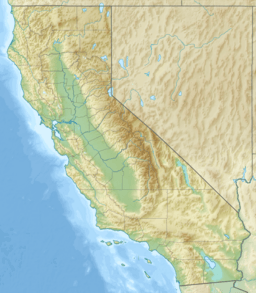Lake Clementine facts for kids
Quick facts for kids Lake Clementine |
|
|---|---|
| Location | California, United States |
| Coordinates | 38°56′38.7″N 121°00′08.5″W / 38.944083°N 121.002361°W |
| Type | Reservoir |
| Built | 1939 |
| Max. length | 3.5 mi (5.6 km) |
| Max. width | 300 ft (91 m) |
Lake Clementine, also called North Fork Lake, is a beautiful reservoir in Northern California. It sits in the North Fork American River Canyon, near the historic town of Auburn. This lake was made in 1939 when the North Fork Dam was built. The dam is 155 feet (47 meters) tall. It was built to help control leftover materials from gold mining that washed into the river.
Lake Clementine is long and narrow, about 3.5 miles (5.6 km) long and 300 feet (91 m) wide in some spots. The United States Bureau of Reclamation owns the lake, and the California Department of Parks and Recreation helps manage it.
Contents
Fun Activities at Lake Clementine
Lake Clementine is a great place for outdoor fun! You can enjoy many activities here, especially in the summer.
Boating and Water Sports
The lake is open for boats. It's a popular spot for water-skiing and wakeboarding during warmer months. If you prefer a quieter time, you can go kayaking, rowing, or fishing.
Hiking and Exploring
The area around the lake has steep, forested canyon walls. There are also cool limestone rock formations. One big rock is known as Robbers Roost. This spot offers chances for climbing and exploring caves if you are adventurous.
A popular trail starts near the dam. It goes downstream below the huge Foresthill Bridge, which is 730 feet (220 m) tall. This trail connects Lake Clementine to other parts of the American River. It also links to a big network of trails that stretch into the Sierra Nevada mountains, close to Lake Tahoe.
The Dam's Waterfall
The dam is designed so that the river flows right over its top. This creates a waterfall! In winter and spring, when there's lots of rain and snowmelt, the river flows strongly. This makes the waterfall grow impressively large and powerful.
Upper Lake Clementine Access
You can reach Upper Lake Clementine by car through a separate entrance. It's open seasonally from May 1st to October 15th, from sunrise until just before sunset. To get there, you'll drive down a 1.5-mile (2.4 km) winding dirt road.
This area has a large beach with small pebbles. You can enjoy activities like canoeing, kayaking, paddle boarding, or even trying your hand at gold panning with a simple pan. Dogs are not allowed in this area. The lower part of the lake can only be reached by boat and has a special boat-in campsite.
Robber's Roost: A Historic Landmark
From the lake and nearby trails, you can see a famous rock formation called "Lime Rock." Locals often call it "Robber's Roost." This name comes from the California Gold Rush days. Back then, this rock was a lookout point for bandits who robbed stagecoaches.
The bandits would watch from the rock to see if a stagecoach had armed guards. If it looked unprotected, they would signal to attack. Some historians believe that Black Bart, a well-known stagecoach bandit, might have been part of this group.
Plants and Animals of Lake Clementine
The area around Lake Clementine is home to many different kinds of plants and animals.
Trees and Wildflowers
Along the lake's shores, you'll find several types of trees. These include various oaks, manzanita (Arctostaphylos manzanita), madrone (Arbutus menziesii), and ponderosa pine (Pinus ponderosa).
In the spring, many beautiful wildflowers bloom. You might see California Poppy (Eschscholzia californica), different kinds of Lupin (Lupinus), and winter vetch (Vicia villosa). Be aware that blackberry (Rubus armeniacus and Rubus ursinus) and poison oak are also common here.
Wildlife You Might See
Many animals live around Lake Clementine. You might spot:
- Mule deer (Odocoileus hemionus)
- Turkeys (Meleagris gallopavo)
- Black bears (Ursus americanus)
- Skunks (Mephitis)
- Squirrels (Sciurus)
- Mountain lions (Puma concolor)
Fish in the Lake
Lake Clementine is home to many fish species, including:
- Rainbow trout (Oncorhynchus mykiss)
- Brown trout (Salmo trutta)
- Largemouth bass (Micropterus salmoides)
- Smallmouth bass (Micropterus dolomieu)
- Bluegill (Lepomis macrochirus)
- Channel catfish (Ictalurus punctatus)
- Green sunfish (Lepomis cyanellus)
- Redear sunfish (Lepomis microlophus)
- Sacramento pikeminnow (Ptychocheilus grandis)
- Common carp (Cyprinus carpio)
About the North Fork Dam
The North Fork Dam is a special type of dam called a variable radius arch dam. This means it has a curve, but the curve changes at different heights. The top part of the dam has a wider curve than the bottom part. This design works very well in V-shaped valleys and can be more affordable to build.
Why the Dam Was Built
In the late 1800s, a type of gold mining called hydraulic mining caused problems downstream. It sent a lot of dirt and leftover materials into the rivers. This made the rivers shallower and increased the risk of floods.
The North Fork Dam was built to help stop these materials from flowing downstream. As a result, the water levels during floods in the channels below the dam have gone down by about 4.3 centimeters (1.7 inches) each year.
Water Quality and History
Because of past mining activities, the American River watershed has faced some water quality challenges. Mercury was used to help extract gold from the sediment. Studies have found mercury in fish below the North Fork Dam. Efforts are ongoing to monitor and improve the water quality in the area.



